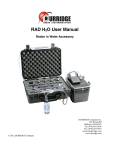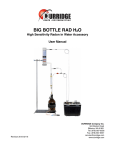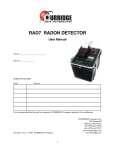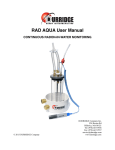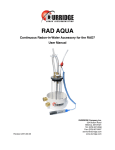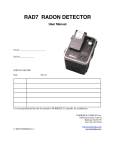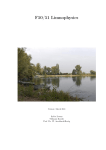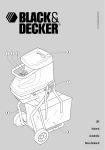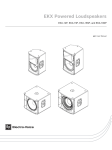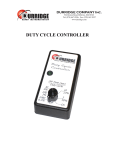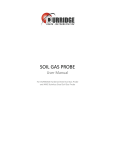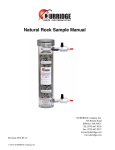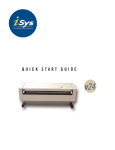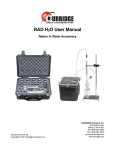Download Range Extender User`s Manual
Transcript
RANGE EXTENDER Accessory for the RAD7 radon detector to extend the range by an order of magnitude. BASIC CONCEPT The Range Extender mixes fresh air with sample air to reduce the concentration of radon in the air fed to the RAD7 by an order of magnitude. To ensure that the ratio of fresh air to sample air is kept constant, the two air samples are pulled through capillary tubes of different lengths. It is important that the pressure drop across both capillary tubes is the same, so the pressure difference between the inputs to the capillary tubes is measured and a needle valve adjusted to bring that pressure difference across the inputs to zero. The outputs of the two paths are joined together to form the mixture sent to the RAD7 so if the inputs are at the same pressure then the pressure drop across each tube must be the same, and thus the ratio of air flows is kept constant. 0.45 micron filters are permanently located on the inputs to both paths to protect the capillary tubes from contamination. The device has a “Push to Test” button that applies voltage to the pressure sensor for several seconds during which the reading may be observed. A second button makes the meter more sensitive for readings close to zero. -2© 2010 Durridge Co., Inc The needle valve is placed on the high radon side of the flow because that has the longer capillary tubing and slower flow rate. The pressure drop across the inlet filter on the high radon side will therefore be less than the pressure drop across the inlet filter on the fresh-air side. The needle valve is used to provide some additional pressure drop on the high radon side to bring the inlet pressure at the capillary tubing entrance to the same pressure as on the fresh-air side. The ratio of flow rates through the two different lengths of capillary tubing will be independent of the pressure drop across the tubes, provided it is the same for both. When the RAD7 pump is off there is no flow in either side and, when the pump is on, the flow rates in the two sides are in a constant ratio. This means the RAD7 pump can cycle on and off without affecting the ratio of the flow rates or the value of the Range Extender multiplier. -3© 2010 Durridge Co., Inc 1. SETUP 1.1 Meter Zero With no tubing connected to the device and without the “Push to Test” button pushed, so that no power is applied to the pressure sensor, the needle of the center-zero meter should lie over the zero mark of the scale, in the center of the window. If not, then the meter zero can be adjusted by rotating the slotted adjuster below the needle. This is a delicate adjustment and should not be attempted unless necessary, and then only with care. 1.2 Electronics Zero Still with no tubing attached to the device, push the “Push to Test” button. The LED will light up. There should be no movement of the needle in the meter. If significant movement is observed, a potentiometer, accessible through a small hole in the top side of the device, may be adjusted to bring the needle back to zero. Adjustment should only be made when power is applied and the LED is lit. A small, flat-blade screwdriver is required to adjust the potentiometer. It is important when adjusting the electronics zero that no tubing be attached to the device. This is because some sources of air may have their own pressure that is different from ambient and even a small difference would be sufficient to apply a pressure difference across the pressure sensor thus producing a signal that would deflect the needle. To ensure that all pressures in the device are equal to ambient, it is necessary to remove all external tubing from the device before adjusting the electronics zero. 1.3 Inlet filters To protect the capillary tubes inside the device, inlet filters are provided for both air inputs. Make sure that these filters are securely in place, with the Luer connections properly mating to prevent any leakage. The inlet filters fit directly onto the range extender, between the range extender and the tubing connections. 1.4 Fresh air connection Fresh air is used to dilute the high radon sample air. It should have less than 0.5% of the sample air radon concentration for no correction (for the radon in the fresh air) to be needed. The upper limit of the linear range of the RAD7 exceeds 10,000 pCi/L (~400,000 Bq/m3) so typically the device will not be used for radon concentrations in the sample air significantly less than 1,000 pCi/L, or 40,000 Bq/m3. 0.5% of that level will be much greater than typical ambient radon concentration, so for normal purposes, when diluting high radon concentration sample air, ambient air will be adequate for the fresh air source. On a still day there will be a significant vertical gradient in radon concentration near the ground, out in the open. To be confident of a low (<0.25 pCi/L or <10 Bq/m3) ambient radon concentration it would be good to have the fresh air sampling point 10 ft (3m) or more above the ground. If the measurement is being made inside a building, the fresh air sampling point should, -4© 2010 Durridge Co., Inc preferably, be outside the building and as high as conveniently possible. If it is a windy location, care should be taken to ensure that there are no big pressure changes in the supply due to shifts in the wind. In or on a wall facing the wind that experiences the full Pitot pressure (static plus dynamic pressure), for example, would not be very good. Please note that in some parts of the world the ambient radon levels may be quite high and perhaps none of the precautions listed above will ensure an insignificant radon concentration in the diluting air. Also, if the device is used to dilute lower radon concentration air, even normal ambient air may not be sufficiently free of radon for its radon concentration to be insignificant. In either of these circumstances, for an accurate calculation of the original high radon concentration, the radon in the diluting air must be removed with an activated charcoal filter or measured and a correction made, see below. Plastic tubing from the fresh air sampling point to the fresh air inlet filter on the device is all the fresh air connection required. 1.5 High-radon air connection Operation of the range extender with some accessories, such as a soil gas probe or a RAD AQUA radon-in-water accessory, need special consideration and are covered later in individual chapters devoted to their cases. Other than that, in general, all that is needed is a plastic tubing connection from the high-radon sampling point to the sample inlet filter on the device. The source should be at, or close to, ambient pressure. If the source is not at ambient pressure, a pressure reduction valve and/or needle valve may be necessary. Alternatively, the fresh air pressure could, perhaps, be changed to match the high radon source pressure. The point is that the range extender needle valve must be adjusted so that the pressure drops across the capillary tubes in both air paths, fresh and sample, are always the same (see below). The extender uses a pressure drop to drive the air through the capillary tubing in the device. The RAD7 pump, therefore, is working against resistance in the air path that reduces the total air flow from around 750 ml/min to about half that. For a ten to one reduction in the RAD7 reading, nine tenths of the air flow will be of fresh air and only one tenth will be of high-radon sample air. Thus, the sample air flow will only be about one ninth of the total flow, or about 50 ml/min (0.05 L/min). With a sample air flow rate of only 0.05 L/min, it may take significant time for the sample to reach the RAD7. For example, if a 1 litre drying unit is interposed between the sampling point and the range extender, it will take 20 minutes for the sample to pass through the drying unit. If response time is of concern, therefore, the drying unit should be placed between the range extender and the RAD7. In that case, only one drying unit is required as all the incoming air, both fresh and high-radon sample, has to pass through it on its way to the RAD7. If response time is not a concern, separate drying units upstream of the Range Extender, one for the high radon sample air and one for the fresh air, would have the advantage that the air passing -5© 2010 Durridge Co., Inc through the capillary tubes is dry. This would provide additional protection for the capillary tubes and prevent the growth of contamination. If the high-radon sampling point is far from the range extender and the RAD7, any effects due to the delay in obtaining the sample will be ten times greater than in making a measurement from the same distance without the range extender. Whereas it is acceptable, for example, to sample soil gas probes up to a kilometer or more away with just the RAD7, special operating procedures (see below) must be adopted to sample from the same distance with the range extender in place. 1.6 RAD7 connection From the ‘outlet to RAD7’ connection on the device, connect tubing to the screw-cap end of a laboratory drying unit charged with dry desiccant. Connect the other end of the drying unit to the inlet filter on the air inlet of the RAD7 (see RAD7 manual). 1.7 Pressure balancing With the system set up, as above with connections made to all three hose connectors, set the pump to ON (Setup, Pump, ON [ENTER]). You will hear the pump operating. Press the “Push to Test” button on the Range Extender and, while the LED is lit, adjust the needle valve until the meter needle is centred on zero. If necessary repeat the process until the needle stays zeroed when the “Push to Test” button is pressed. If desired, once a rough zero is achieved, the highsensitivity button may be pressed to give a more sensitive indication of the pressure difference. With the RAD7 pump not running, check the pressure balance once more. If there is a pressure difference, it means that one or the other air source is not at ambient pressure. This can cause a problem as the excess pressure may drive air through the system even when the RAD7 pump is not running. Once the pressure balancing is complete, and if there is no source pressure problem, set the pump to AUTO. The Range Extender is now set up, ready for use. If there is a source pressure problem, then immediately prior to starting the measurement set the RAD7 pump to ON (Setup, Pump, ON [ENTER]) so that the pressure is balanced for the duration of the measurement and there are no intervals with the pump off for the source pressure to push a wrong mixture through the system. After the measurement is complete, the pump should be reset to AUTO to turn off the pump. The pressure balance may be checked at any time during a measurement (by pushing the “Push to Test” button) and the needle valve adjusted if necessary. -6© 2010 Durridge Co., Inc 2. Measurement 2.1 Operation Once the Range Extender is set up and the pump reset to AUTO, the RAD7 may be operated in whatever protocol the user wishes. 2.2 No Passive DRYSTIK Because of the significant reduction in pressure between the Range Extender and the RAD7 pump, it is recommended that a passive DRYSTIK humidity exchanger not be used in this setup. Not only would it be less efficient, because of the low pressure, but also the inner membrane tubing will be more likely to collapse under the suction generated by the RAD7 pump. An Active DRYSTIK would, however, be fine. 3. Calculation 3.1 Standard With the fresh air radon concentration less than 0.5% of the high-radon sample air radon concentration, any error due to radon in the fresh air will be less than 5% of the reading, and may therefore be ignored. The reading on the RAD7 should be multiplied by the device multiplying factor, as indicated on the Range Extender itself. If A = radon concentration reading M = multiplying factor Then sample, high-radon concentration, R, is given by R = MA 3.2 Non-standard If the diluting air has a radon concentration more than 0.5% of the sample air, then a correction has to made as follows: Let A = radon concentration reading B = Fresh air radon concentration R = Sample radon concentration M = Multiplying factor of Range Extender -7© 2010 Durridge Co., Inc In standard conditions, with a multiplying factor M, the flow of high radon air is 1/M of the total flow and the flow of fresh air is (M – 1)/M of the total flow. So the air flowing to the RAD7 will have a radon concentration of R/M + (M – 1)*B/M. Now (M – 1)/M will be about 0.9 and, if B is small compared with R, (M – 1)/M may be considered to be equal to 1. Thus the air flowing to the RAD7 will be nearly R/M + B. Therefore, before applying the multiplying factor, the fresh air concentration, B, should first be deducted from A, the RAD7 radon concentration reading. That is: R = M(A – B) 4. Use with Soil Gas Probe 4.1 Air flow A typical sample airflow rate into the Range Extender would be around 0.05 L/min. This can be advantageous in that a continuous monitoring of soil gas radon concentration is feasible. A 10 cm radius sphere around the sampling point has a volume of about 4L. At 0.05 L/min, this would take over an hour to draw. A 20 cm radius sphere would take 10 hours to draw. So, with the Range Extender, it is possible to monitor the radon concentration of soil gas for many hours, thus getting a very precise measurement, without drawing so much soil gas that there is any danger of fresh air reaching the sampling point by diffusion through the soil. 4.2 Sample delay On the other hand, the very slow sample flow rate has the disadvantage that it may take considerable time for the soil gas to enter the RAD7. If the inside diameter of the soil gas probe is 0.5 cm and it is 1 m long, the volume will be about 20 ml. If the tubing between the probe and the Range Extender has an inside diameter of 3 mm (about 1/8”), the volume per metre will be about 7 ml. With two or three metres of tubing, the total volume would be less than 50 ml and the sample would take less than one minute to reach the Range Extender and sample delay would not be an issue. If the soil gas probe is some distance from the Range Extender, then sample delay may be an issue. For example, with the tubing above, if the probe is 1 km from the Range Extender, the volume of the tubing will be 7 L and the sample delay would be 140 min or over 2 hours. Not only would this require waiting for three hours to get a reading, but also the reading obtained would need correction for the decay of the radon in the sample air during the 2.3 hours it spent traveling along the tubing. A strategy to make it possible to sample from far remote probes without having to wait for hours for the sample to arrive is to use an external pump to purge the tubing with sample air just prior to the measurement. In other words, an external pump is attached to the tubing and run until 7 -8© 2010 Durridge Co., Inc L has been drawn from the soil gas probe. The tubing is then connected to the Range Extender and a measurement started. Now the RAD7 will be drawing a valid sample almost immediately. The measurement can be continued for an hour or more with minimal loss of radon from radioactive decay in the sampling tube. With an Active DRYSTIK and Duty Cycle Controller, soil gas may be sampled continuously indefinitely, with a nearby soil gas probe, without dilution of the sample. 5. Use with the RAD AQUA 5.1 Water levels in a standard RAD AQUA. In a standard RAD AQUA setup, all the air drawn from the top hose connection is returned to the RAD AQUA. All water has some dissolved gases in it. Usually the concentration of dissolved gases is slightly more than can be supported at equilibrium at atmospheric pressure. So there is some out-gassing during the spray process occurring inside the spray chamber. As a result, the water level in the RAD AQUA drops until there is a net outflow of air through the water release channels at the bottom of the spray chamber. In a rare situation of insufficient dissolved gases, so that the water level inside the RAD AQUA rises, a bleed may be connected to the ingoing tube to allow air to enter the system to replace that lost in the spray process. This can be inserted between the return check valve and the hose connection on the RAD AQUA. 5.2 Unequal flows with the Range Extender. With the Range Extender in the circuit, there is ten times more air being fed back to the RAD AQUA than being drawn from it. This is not a serious problem, but the air coming in is not in equilibrium with the water as it has been diluted to one-tenth the equilibrium concentration. Much of the incoming air will be blown out of the bottom of the RAD AQUA, but it will take with it some air closer to equilibrium with the water, thus making it harder for the RAD AQUA to keep the air in equilibrium near the top of the exchanger from where the sample air is drawn. To limit the air returning to the RAD AQUA to the same flow as that leaving from the top hose connection, a simple T-connection with a few inches of tubing connected to it, inserted between the return check valve and the RAD AQUA return hose connection will provide a passage for the excess return air to escape. There will then be only 0.05 L/min airflow through the RAD AQUA. This will give plenty of time, provided the water flow rate is more than 0.5 L/min, for the returning air to recover to equilibrium with the water inside the exchanger before the air is once more on its way to the Range Extender. -9© 2010 Durridge Co., Inc 6. Maintenance and trouble shooting 6.1 Pressure Balance Should it ever become impossible to adjust the pressure difference to zero, with the needle valve, it may be because one or other air supply is at a pressure far from ambient. To check this, disconnect both air supplies, set the RAD7 pump to ON and attempt to reduce the pressure difference to zero by adjusting the needle valve. If a zero setting, with supplies disconnected, is now possible, look for reasons why one or other supply is not at ambient pressure and try to fix the problem. Reconnect the supplies and observe the pressure difference with the RAD7 pump not running. If the input pressure of the two air supplies cannot be changed, it may be possible to fix the problem by stacking additional inlet filters on the higher-pressure supply to the Range Extender, thus creating an additional pressure drop as the airflow enters the Range Extender. In this case, as in every case where the source pressures are not ambient, the measurement should be made with the RAD7 pump running continuously (see above). If a zero balance is impossible even with the supplies disconnected, there is a problem with the Range Extender. Most likely it will be due to a dirty inlet filter. Therefore, replace both inlet filters and try again. If this still does not solve the problem, there may be some blockage of a capillary tube inside the Range Extender. Provided the Range Extender is never used without the supplied inlet filters in place, it should never be blocked by any contamination. However, if blockage occurs, the device has to be returned to DURRIDGE Company for repair and recalibration. 6.2 Batteries The Range Extender uses 4 AA cells, provided. The electronics when not in use draw a microscopic current that will discharge the batteries over 6 months to a year. The current draw during a reading, after pushing the “Push to Test” button, is small. So, in regular use, the batteries can be expected to last several months. When the batteries need replacing, observed by a dim panel light and unresponsive meter, the battery compartment on the faceplate may be removed and the batteries replaced. - 10 © 2010 Durridge Co., Inc










